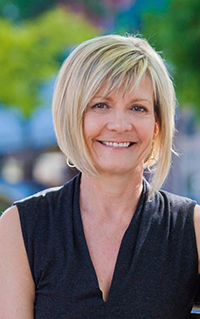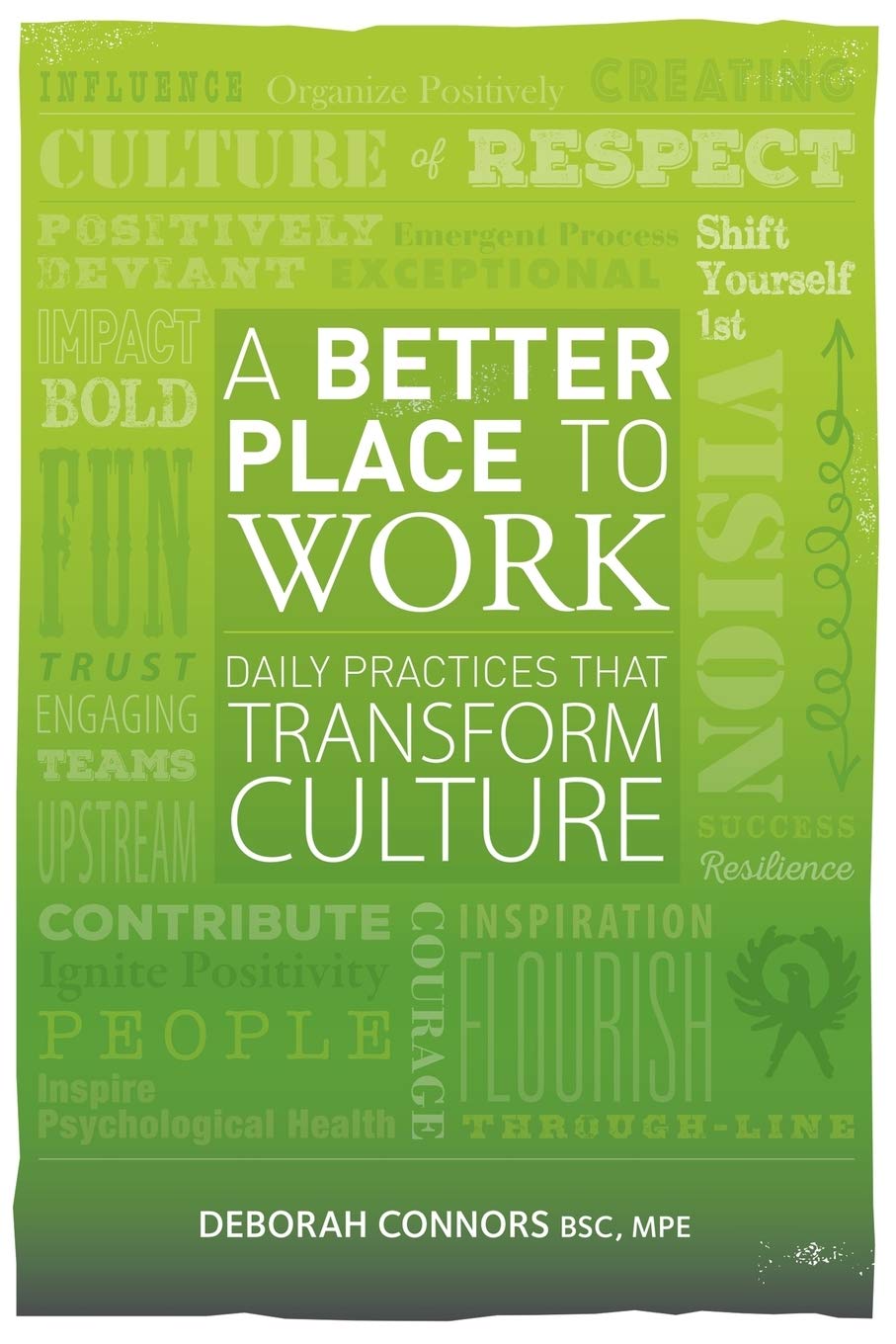A Better Place to Work: Daily Practices That Transform Culture
by Deborah Conners
About the Book
In many organizations the culture is one of crises and overload, and work is about surviving versus thriving. The human and financial costs of negative work cultures are huge, but there is hope. This book is a practical guide full of stories of transformative workplace change. It is a synthesis of advice from business and organizational health experts which provides over 50 daily practices that support creativity, innovation and proactivity at work. It will inspire you to become positively deviant and overcome workplace negativity to create a culture of possibility where productivity soars and people flourish.
Deborah is a prominent figure in the story of how Canadian workplaces have adopted practices to become better places to work, a position she achieved through her development of The Better Workplace Conference. This powerful initiative, which she successfully led for 17 years, created a whole generation of workplace health professionals and a huge community of practice. She has brilliantly distilled the knowledge from in-depth interviews with ten featured influencers and combined it with her own leadership experience to bring you the best of what we know to date on shifting workplace culture, along with how it benefits the organization and the individuals who work there. Deborah is a captivating speaker, storyteller, author and workplace coach who researches the latest breakthroughs in organizational health around the globe. She teaches leaders how to radically shift culture so that people can flourish.
About the Author
When Deborah went back to university to do her Master’s degree in the eighties, she wanted to study organizational health. However, there was no such degree at the time. She was able to find the right advisors and create a program that allowed her to conduct research on health promotion in organizations. She then started her consulting business, Well-Advised Consulting Inc., which provides support to organizations wanting to create more positive and healthy work cultures.
In the nineties, when there was no annual conference in Canada on organizational health, Deborah had the vision to develop the Health Work & Wellness™ Conference (now branded The Better Workplace Conference), a national event that she led for 17 years.
Now she has captured the knowledge and best-advice from an entire community of organizational health professionals, researchers and business leaders that came together annually for her event. She conducted in-depth interviews with ten featured influencers in the organizational health field in order to create “A Better Place To Work: Daily Practices That Transform Culture” and to inspire her keynotes, retreats and in-house workshops.
A captivating speaker, storyteller, author and workplace coach, Deborah researches the latest breakthroughs in organizational health and culture around the globe. She teaches leaders how to radically shift culture so that people can flourish.
Deborah lives on Vancouver Island with her husband Mike and their youngest daughter Jordan. She is happiest when she is on stage teaching or on the mountain skiing with her family.
Amazon Central Author Page – www.amazon.com/Deborah-Connors/e/B07BS434TM/
Goodreads Author Page – www.goodreads.com/author/show/17708688.Deborah_Connors

Interview with Deborah Conners
Please share a bit about your journey to become a published author?
Something magical happened in the fall of 1997. If you were one of the 550 people who walked into the Hotel Vancouver to the very first Health Work & Wellness™ Conference in Canada you will know exactly what I’m talking about. The energy and excitement was palpable. There had never been another forum of this kind in the country and people with different backgrounds from workplaces across the nation and beyond came to be a part of the inaugural event.
After leading my last conference in 2013 (then branded The Better Workplace Conference), I thought back over the 17 years of how this event evolved and I knew there was a book to be written. It was going to be about the conversations that were shared on shifting to a more positive workplace culture by innovators and influencers from around the world. I had the unique opportunity to meet and get to know hundreds of incredible thought-leaders, researchers and keynote speakers in the process of founding and leading this event, and I conducted in-depth interviews with ten of the speakers that I was particularly inspired by. This book shares their brave and inspiring stories, some very personal and painful, so that others can benefit from their wisdom and experience. It is a compilation of the best advice from some of the world’s top organizational health experts which shows that if we change our culture, we change our outcomes.
As I started to write, I took a course with Carla Rieger that helped me to peel back the layers and get to the core of what I had to offer to the world. In that process and through my research it became apparent that the key to positive culture change lies in what we practice on a day to day basis as leaders. So this book includes over 50 daily practices that support building a culture where people can flourish and exceed expectations.
Knowing nothing about the publishing industry, I took another online course with Julie Salisbury of Influence Publishing and learned how complex and ever-changing this industry is. That is when Julie became my partner in publishing this book. The online course was useful in mind-mapping the concepts and chapters in the book, and also understanding the various supporting pieces that I needed to gather and develop (testimonials, pictures, back cover copy, etc.) It has been invaluable to have a partner to check in with throughout the process.
Show More
How does the writing process work for you? Do you schedule a time every day, work madly when inspiration hits or?
I took another online course with Patti Digh, one of my favourite authors, called Organizing Your Writing Life. This turned out to be not at all about getting my files in order, but all about what blocks us from writing (which is never about having a messy office!) Through this course I was inspired to develop writing rituals. Although inspiration doesn’t happen because you sit down and write everyday, it does help to have that steady ritual. Mine is a short meditation, followed by making a nice cup of coffee and then sitting to write. Having said that, I also fit in minutes between my daughter’s volleyball games and sitting in the passenger seat of the truck going back and forth to Alberta to see my parents. If I had waited until I had big blocks of time to write it would still not be finished.
Inspiration often comes in the spaces between writing though. It is in stepping away from a chapter for a few weeks and being able to reflect, that the magic happens.
What did you find most difficult about the writing and publishing process? What was the easiest?
I think the most difficult and tedious part for me was the referencing at the end. The basis of my book was the in-depth interviews with the experts, but I backed this up with research studies and I didn’t properly take note of all the references as I was writing, which meant a lot of searching at the end to properly reference my work.
The easiest part was doing the interviews. I loved the conversations with the experts and then going back through what I had recorded and finding the nuggets from each interview.
What title (or titles) have you released? Please include a short synopsis of what your book is (or books are) about.
The book I am releasing now is my first. The title is: A BETTER PLACE TO WORK Daily Practices That Transform Culture. This book is about daily practices that anyone can adopt that will transform you and the culture around you. Practically everyone I talk to says their workplace needs to shift. They often talk about overwhelm and exhaustion, or negativity that they experience at work. What I want people to know is that there are many evidence-based daily practices they can adopt that will begin to shift this culture. Anyone, at any level in their organization can impact positive change. This book was written to show you how! The BE POSITIVE framework introduced in this book provides over 50 daily practices that support creativity, innovation and proactivity at work.
Do you have any new books in the planning or writing stage?
Not yet, but I think there will be a second edition to this book. I already have a list of ten more experts that I want to interview.
What would you like readers to know about you? (please share about your business, career, passions, etc.)
Having a bad experience in a workplace as a young employee over 25 years ago made me think There has to be a better way to do business. This thought is what made me start and lead The Better Workplace Conference for 17 years. It’s my “WHY.” It is why I have spent the past 30+ years devoting my work to creating better workplaces, and it is why I wrote this book.
I am passionate about helping organizations become more positive and healthy, and I am encouraged to see the interest and openness that today’s leaders have to these practices. I am happiest when I am teaching—presenting keynotes on stage or facilitating workshops with small groups.
What do you hope readers will take away from your book?
One of the most transformational questions you can ask in your workplace is simply, “What do we want our culture to be?” Once you create that vision, your next question is, “What will we do differently to create a better place to work?”
I suggest that you keep this question in mind as you work through the chapters and practices introduced in the BE POSITIVE framework in my book. I introduce a personal leadership plan that I call the ’Through-line Approach’ and recommend that you pick one, two or three new practices that you want to try, being open to the possibilities of what will emerge in your teams and organizations from developing these new habits.
I want you to use this book as a practical guide to change—writing in the margins, working through the activities at the end of each chapter, highlighting things that jump out at you and tailoring these ideas to fit your own culture.
